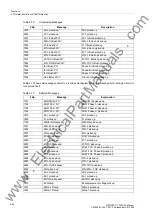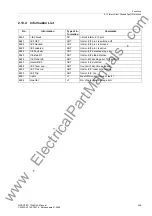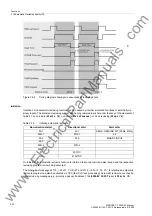
Functions
2.14 Automatic Reclosing System 79
SIPROTEC, 7SJ62/64, Manual
C53000-G1140-C207-2, Release date 01.2008
257
• If binary input 4602
„>52-b“
alone is allocated, the circuit breaker is considered open while the binary input
is active. If the binary input becomes active while no trip command of (any) function applies, the automatic
reclosure system will be blocked dynamically provided it is already running. Otherwise the blocking will be
a static one. The dead time is started if the binary input becomes active following the trip command of a start-
ing element. An intermediate position of the circuit breaker cannot be detected for this type of allocation.
• If neither binary input 4602
„>52-b“
nor 4601
„>52-a“
are allocated, the automatic reclosure program
cannot detect the position of the circuit breaker. In this case, the automatic reclosure system will be con-
trolled exclusively via pickups and trip commands. Monitoring for "52-b without TRIP" and starting the dead
time in dependence of the circuit breaker feedback is not possible in this case.
Circuit Breaker Monitoring
The time needed by the circuit breaker to perform a complete reclose cycle can be monitored by the 7SJ62/64.
Breaker failure is detected:
A precondition for a reclosing attempt, following a trip command initiated by a protective relay element and sub-
sequent initiation of the automatic reclosing function, is that the circuit breaker is ready for at least one TRIP-
CLOSE-TRIP cycle. The readiness of the circuit breaker is monitored by the device using a binary input
„>CB
Ready“
. In the case where this signal from the breaker is not available, the circuit breaker monitoring feature
should be disabled, otherwise reclosing attempts will remain blocked.
• Especially when multiple reclosing attempts are programmed, it is a good idea to monitor the circuit breaker
condition not only prior to the first but also to each reclosing attempt. A reclosing attempt will be blocked until
the binary input indicates that the circuit breaker is ready to complete another CLOSE-TRIP cycle.
• The time needed by the circuit-breaker to regain the ready state can be monitored by the 7SJ62/64. The
monitoring time
CB TIME OUT
expires for as long as the circuit breaker does not indicate that it is ready via
binary input
„>CB Ready“
(FNo. 2730). Meaning that as the binary input
„>CB Ready“
is cleared, the
monitoring time
CB TIME OUT
is started. If the binary input returns before the monitoring time has elapsed,
the monitoring time will be cancelled and the reclosure process is continued. If the monitoring time runs
longer than the dead time, the dead time will be extended accordingly. If the monitoring time elapses before
the circuit breaker signals its readiness, the automatic reclosure function will be blocked dynamically.
Interaction with the synchronism check may cause the dead time to extend inadmissibly. To prevent the auto-
matic reclosure function from remaining in an undefined state, dead time extension is monitored. The maximum
extension of the dead time can be set at
Max. DEAD EXT.
. The monitoring time
Max. DEAD EXT.
is started
when the regular dead time has elapsed. If the synchronism check responds before the time has elapsed, the
monitoring time will be stopped and the close command generated. If the time expires before the synchronism
check reacts, the automatic reclosure function will be blocked dynamically.
Please make sure that the above mentioned time is not shorter than the monitoring time
CB TIME OUT
.
The time
7114
T-Start MONITOR
serves for monitoring the response of the automatic reclosure function to
a breaker failure. It is activated by a trip command arriving before or during a reclosing operation and marks
the time that passes between tripping and opening of the circuit breaker. If the time elapses, the device
assumes a breaker failure and the automatic reclosure function is blocked dynamically. If parameter
T-Start
MONITOR
is set to
∞
, the start monitoring is disabled.
www
. ElectricalPartManuals
. com
















































